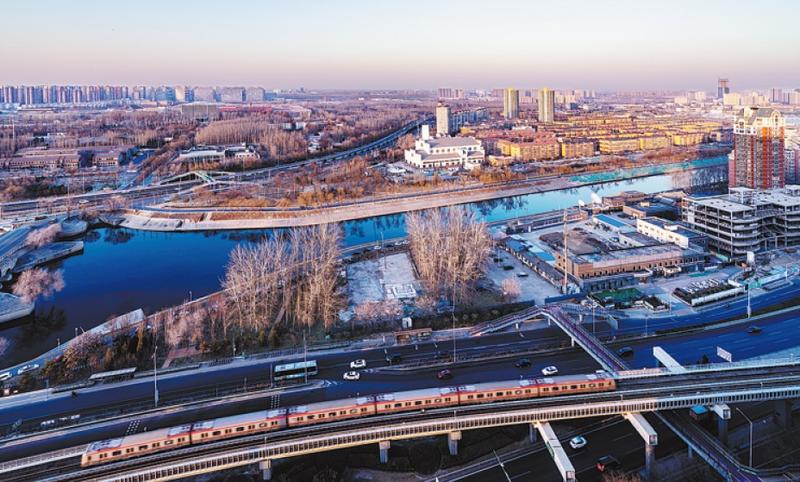 A train runs through Tongzhou district in Beijing. The city's subcenter has expanded its transportation network over the past five years. (PHOTO PROVIDED TO CHINA DAILY)
A train runs through Tongzhou district in Beijing. The city's subcenter has expanded its transportation network over the past five years. (PHOTO PROVIDED TO CHINA DAILY)
Beijing's subcenter in Tongzhou district has made remarkable progress in industrial development over the past two years, according to a top official from the subcenter's management committee at a news conference held last week.
Beijing's subcenter was planned to be home to the capital's key municipal agencies and aims to relieve pressure on the downtown area
Zhang Yanlin, also deputy director of the Beijing Development and Reform Commission, said the subcenter's GDP reached a record high of nearly 106 billion yuan (US$16.23 billion) in 2019.
This year, the subcenter had added more than 16,700 companies from January to November despite the impact of the COVID-19 pandemic, ranking third in the city.
Its GDP exceeded 78 billion yuan in the first three quarters, an increase of 2 percent year-on-year, higher than the capital's average growth rate. The added value of the financial industry reached 7.13 billion yuan, a year-on-year increase of 29 percent, which provided strong support for regional economic growth, Zhang said.
ALSO READ: Progress in developing capital city subcenter
The total added value of information transmission, software and information technology services reached 740 million yuan in the first nine months, up 6.5 percent, and scientific research and technical services achieved 2.06 billion yuan in value added, up 10 percent.
The statistics show that the subcenter this year has ensured steady economic growth and achieved initial results in nurturing industries, Zhang added.
Beijing's subcenter was planned to be home to the capital's key municipal agencies and aims to relieve pressure on the downtown area. Last year, the capital saw its first batch of municipal-level government organs move their offices to Tongzhou.
To better optimize the local industrial structure, Zhang said the authorities have formulated a series of special policies that are in line with the subcenter's actual needs, which cover housing, land use, finance and human resources.
The orderly relocation of Beijing's State-owned enterprises is a key issue for the subcenter's future development.
Currently, five SOEs-Huaxia Bank, Beijing Tourism Group, Beijing Investment Group, Beijing Institute of Architectural Design and Beijing Public Housing Center-are progressing smoothly in choosing new sites and making relocation plans.
Beijing Investment Group has moved its headquarters and 10 affiliates to Tongzhou, and the rest have changed the registered addresses of their headquarters and branches.
The subcenter has also focused on introducing major projects to speed up the gathering of financial resources. It now boasts a high-level branch of Huaxia Bank, China-Bond Fintech Information Technology and the China Beijing Environment Exchange.
It will also be home to a financial technology company, which is a wholly owned subsidiary of the Agricultural Bank of China, and the Beijing Institute of Finance and Sustainability.
The upcoming 14th Five-Year Plan (2021-25) period is vital in realizing the high-quality development of the subcenter, Zhang told the news conference.
READ MORE: Key projects push Zhanjiang forward as subcenter
The subcenter has set a series of goals to achieve during the period, and is expected to experience leapfrog development in the promotion of Beijing-Tianjin-Hebei coordinated development, and to improve the overall economic strength and the local people's living standards, Zhang said.
A comprehensive transportation hub under construction in Tongzhou is also a major project in the next five years.
The hub is designed to connect three subway lines and three railways, and will be put into operation by the end of 2024. It has an underground section and is expected to be the largest underground transportation hub in Asia.
Also, a group of higher education institutions, including Renmin University of China and Beijing Jingshan School, will build their new campuses in the subcenter. In addition, a batch of high-quality medical and sports facilities will be added to the district, Zhang added.



